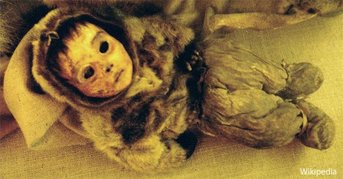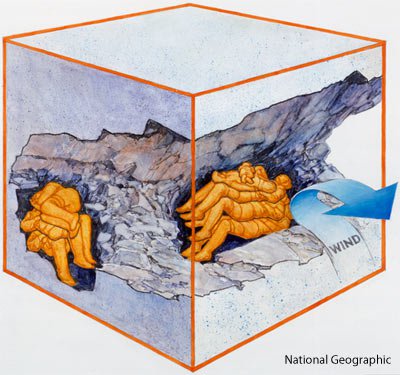The most famous case of mummification is in ancient Egypt, but that was a process that took much time. In several cases there is such a thing as accidental mummification. An example of this accidental mummification are the “Greenland Mummies.” In 1972 a group of a six month old baby, a two year old boy, and six women were found in a shallow cave, and three women found in a second grave that dated back to 1475 c.e. It seemed to be meant as a mass family grave because after their DNA was studied it was found that all, except one, were related (it is theorized the one that did not have DNA in common was family by marriage). All of who was buried were dead before placed there, that is everyone but the six month old baby (image below), who "was found to have Down’s Syndrome and may have been left out to die of exposure because of his condition," also his mother had died earlier, so there was no one to watch over him. These bodies were mummified naturally by two factors. First was the temperature, which was sub-zero, and second were the winds. When there is wind in sub-zero temperatures it is a dry, dehydrating wind (image below). So, in a sense, the six month baby was mummified alive. In my blog about human soap (http://anthropologicalconcepts.weebly.com/blog/-human-soap), I described how bog bodies are formed. They are another example of accidental mummification.
But what happened to all of our evolutionary ancestors that they were able to be fossilized? They could have drowned and their body deposited in the water bed covered by sediment (this one is ideal), they could have suffocated on ash during a volcanic eruption, or just buried (there is evidence that pre-historic hominids buried their dead). That said, most of the dead we have buried through the ages probably have begun to fossilize (the caskets rot away leaving the body, or what is left of it, to the earth).Yet, even though mummification and fossilization look completely different in the outcome, they are in the end, fossilized.
Please feel free to comment on what you thought of the blog, or other physical anthropological subjects you would like me to cover.


 RSS Feed
RSS Feed
